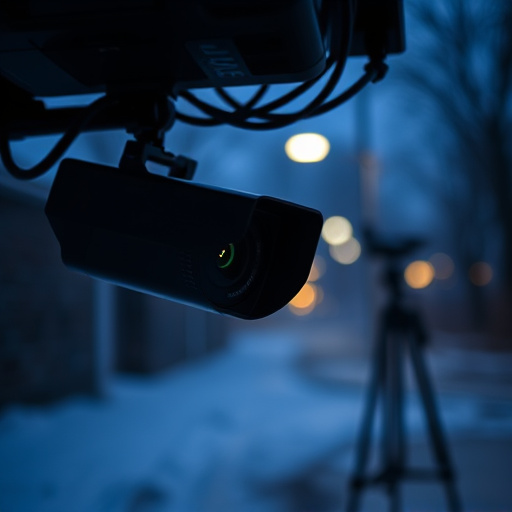Using Nanny Cam With Sound Recording in rental properties requires navigating legal and ethical considerations. Landlords must respect tenants' privacy, inform them about cameras, obtain consent, and ensure secure data handling to avoid legal repercussions and foster trust. Discreet placement near common areas or blending into fixtures is recommended for effective surveillance while minimizing detection risk.
In the digital age, homeowners increasingly turn to nanny cams with sound recording as a means of monitoring their rental properties. However, navigating the legal boundaries and ethical implications of secret surveillance spots within rental units is paramount. This article delves into the key aspects of tenant monitoring, including understanding legal restrictions, identifying discreet placement for surveillance devices, evaluating the role of sound recording, assessing privacy risks, and implementing security measures that respect individual privacy.
- Understanding Legal Boundaries of Nanny Cameras
- Identifying Discreet Placement for Surveillance Devices
- The Role of Sound Recording in Tenant Monitoring
- Potential Privacy Risks and Ethical Considerations
- Effective Security Measures Without Invading Privacy
Understanding Legal Boundaries of Nanny Cameras
In the age of advanced technology, it’s understandable that landlords and homeowners alike are drawn to the idea of installing nanny cameras for peace of mind. However, understanding the legal boundaries surrounding these devices is paramount to avoid any potential privacy breaches or legal issues. The use of a nanny camera with sound recording capabilities, for instance, must adhere to strict regulations to protect tenants’ rights.
Many jurisdictions have specific laws governing the installation and use of surveillance equipment, including cameras with audio functionality. These laws typically require explicit consent from all parties involved, especially in rental properties where both the landlord and tenant have rights and responsibilities. Using a nanny camera without proper notification or consent could violate these legal boundaries, leading to severe consequences for the installer. It’s crucial to inform tenants about the presence of such devices and ensure they are aware of their privacy rights, fostering an environment of trust and transparency.
Identifying Discreet Placement for Surveillance Devices
When setting up secret surveillance in rental properties, the key is to choose discreet placement locations for maximum effectiveness and minimal detection risk. Given that a common method involves using Nanny Cams with sound recording capabilities, these devices should be strategically placed where they can capture relevant activity without raising suspicions. For example, placing them near common areas like living rooms or kitchens offers coverage of high-traffic zones, while also allowing for the monitoring of interactions between occupants and visitors.
Additionally, taking advantage of existing fixtures and features within the property can make these surveillance devices nearly invisible. Mounting cameras behind mirrors, inside decorative frames, or even integrating them into light switches or outlets can provide covert placement that blends seamlessly with the environment, ensuring continuous observation without compromising privacy or prompting alarm from tenants.
The Role of Sound Recording in Tenant Monitoring
In today’s digital era, the practice of secret surveillance in rental properties has evolved significantly, with technology playing a pivotal role in tenant monitoring. One of the most insidious yet effective tools is the Nanny Cam With Sound Recording. This compact and discreet device allows landlords or property managers to observe and listen to various activities within the premises without tenants’ knowledge. The integration of sound recording enhances the capabilities of these surveillance systems, transforming them from mere visual monitors to all-encompassing tools that capture every whisper and murmur.
This technology raises significant privacy concerns among tenants, who may feel their personal spaces are being invaded. However, proponents argue that it serves as a powerful deterrent for potential criminals and helps in verifying the integrity of tenant agreements. The Nanny Cam With Sound Recording thus becomes a double-edged sword, balancing the delicate act of property security against the preservation of tenant privacy.
Potential Privacy Risks and Ethical Considerations
The installation of hidden cameras, such as nanny cams with sound recording capabilities, in rental properties raises significant privacy risks and ethical concerns. While these devices can offer peace of mind for landlords or property managers, they infringe on the reasonable expectation of tenants to have a private space. Tenants may feel constantly monitored, eroding their trust and potentially leading to a hostile living environment.
Ethical considerations also come into play when discussing secret surveillance. The use of nanny cams with sound recording must be transparent to avoid invading tenants’ personal lives. Landlords should establish clear policies on camera usage, provide consent forms, and ensure that any recorded data is securely stored and accessible only to authorized personnel. Failing to do so could lead to legal repercussions, breach of tenant privacy laws, and damage to the landlord-tenant relationship.
Effective Security Measures Without Invading Privacy
Implementing effective security measures in rental properties is essential, but balancing privacy concerns is crucial. Landlords and property managers must strike a delicate line between ensuring tenant safety and maintaining a sense of private space. One method that has gained popularity for its covert nature is the use of Nanny Cams with sound recording capabilities. These devices offer a discreet way to monitor activities without raising awareness among tenants, providing valuable peace of mind for property owners.
However, it’s important to remember that the presence of such surveillance equipment should be transparently communicated to tenants to avoid any ethical dilemmas or legal issues. Responsible use of Nanny Cams involves informing residents about their existence and purpose, ensuring they give informed consent. By doing so, landlords can maintain a secure environment while respecting the privacy rights of their tenants.
While a Nanny Cam with sound recording can enhance security, it’s paramount to navigate legal boundaries and ethical considerations. Balancing tenant privacy with effective monitoring requires discreet placement, understanding of legal limits, and implementation of robust security measures that respect individual rights. By adhering to these principles, landlords can maintain a safe environment without invading tenants’ personal spaces.
